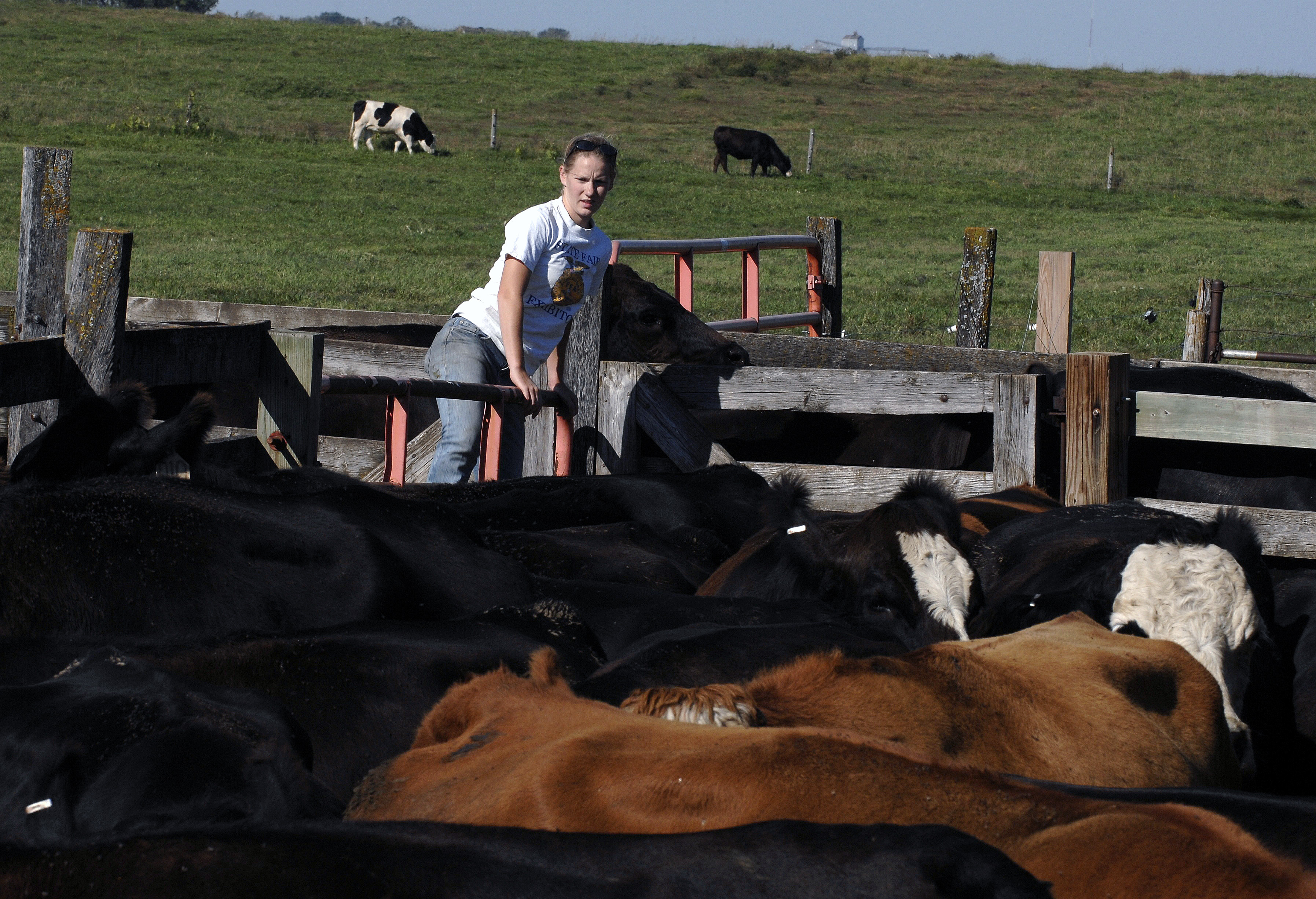
A student works with beef cattle at the ISU Beef Teaching Farm. Larger photo. Photo by Iowa State University College of Agriculture.
AMES, Iowa – Some of the key safety nets that benefit crop farmers dealing with this year’s scorching drought won’t help livestock producers who have been saddled with high feed costs and growing uncertainty, according to two agricultural experts at Iowa State University.
Chad Hart, an Iowa State University Extension and Outreach grain markets specialist and associate professor of economics, said that crop insurance will provide grain farmers an influx of revenue later this year, which will help mitigate the financial impact of this year’s drought. In addition, the drought has driven corn prices to near record highs, which also will take some of the sting out of this year’s dry conditions for grain farmers.
While the drought has created hardship for farmers across the spectrum, it’s more difficult to find a silver lining if you’re a livestock producer, Hart said. Crop insurance doesn’t help cattle or swine producers, and the high corn prices will only make it more expensive for farmers to feed their herds.
“There’s going to be a tremendous flow of dollars late this year in the form of crop insurance,” Hart said. “That’s going to help offset some of the effects of the drought. But there are fewer options for livestock, and that’s going to create some headaches for producers.”
Making matters worse, this is the second consecutive year drought has slammed the livestock industry. States like Texas and Oklahoma battled witheringly dry conditions last year, sparking trends in the beef industry that have carried over into 2012’s drought. U.S. beef cow slaughter totals surged in 2011, driven in part by drought-stricken producers in the Southwest liquidating or reducing their herds. Beef cow slaughter in 2012 generally has tracked below the 2011 totals and has more closely resembled the averages taken between 2006 and 2010, according to the U.S. Department of Agriculture National Agriculture Statistics Service.
However, slaughter numbers for beef and dairy cows jumped to a total of over 132,000 during the third week of July, overtaking the 2011 total for the same week by 3.6 percent and the average slaughter figures from 2006-2010 by 17.5 percent.
“As feed prices rise, producers are doing the math and figuring that it makes more sense to reduce their herds in many cases,” said Lee Schulz, ISU Extension and Outreach livestock specialist and assistant professor in economics. “This trend emerged during the 2011 drought, and we’re seeing it manifest in other ways this year.”
Schulz said this year’s more widespread drought has had a greater impact on Midwestern dairy states, and the resulting higher feed prices have pushed producers to cull more dairy cows than in previous years. More than 60,000 dairy cows were slaughtered in the third week of July 2012, a 22.3 percent increase over the same week in 2011.
Schulz warns against a widespread reduction of cattle herds before it becomes clear what sort of grain yields farmers will get this year. Instead, he encourages producers to ride it out at least until corn can be harvested. If yields are better than expected, feed prices may drop, he said.
“In general, it’s probably best to hold off on making big changes before we know what the yields will look like,” he said. “A mistimed reaction that puts even more animals on the market could make things worse.”
Farmers looking to Washington, D.C., for help have gotten decidedly mixed results. The U.S. Department of Agriculture has provided some relief by allowing farmers to use conservation land and some wetlands for grazing and pasture.
However, Congress failed to pass a comprehensive farm bill before adjourning for a weeks-long August recess while the programs governed by the current farm bill are set to expire in September. Additionally, the U.S. Senate adjourned without taking action on legislation approved by the House of Representatives that would resurrect expired programs aimed at providing emergency relief to livestock producers.
“The USDA has already fired the only bullet at its disposal, and there isn’t much else that can be done without the approval of Congress,” Hart said.
For now, livestock producers are stuck with uncertainty. As the drought persists, they don’t know how this year’s crop yields will impact feed prices or if Congress will take action on key agricultural programs that will impact their operations.
Schulz said that some producers may have dispelled some of that uncertainty by locking in feed prices months in advance. He said that may have temporarily created a safety net for some producers.
“We definitely encourage livestock producers to lock in those feed prices well in advance,” Schulz said. “This year is a perfect example of how important it is for producers to take advantage of risk management strategies.”